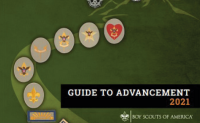 Have you ever been called upon to do some training but weren’t sure how you would do? It could be training Cub leaders, perhaps other committee members in how to do a board of review, or teaching Scouts about leadership – almost all of us are put in a position where we need to teach something to someone else.
Have you ever been called upon to do some training but weren’t sure how you would do? It could be training Cub leaders, perhaps other committee members in how to do a board of review, or teaching Scouts about leadership – almost all of us are put in a position where we need to teach something to someone else.
To gain some perspective. remember the first time you attended a training session. Were you greeted when you came in, or did the training staff huddle around the coffee pot? Did the trainer deliver the material with a personal touch, or did she simply read the slides on the screen? Did you feel comfortable asking questions?
You can probably guess that your personality has as much to do with being a successful trainer as knowing the material does. There are some basic skills that you need to practice in order to be an effective trainer. You need to know the subject matter, of course, but you also need to be able to relate it to the people you’re training, at a level that’s compatible with their experience and ability to comprehend.
Training adults is one thing; training youth is quite another, and the methods differ. Most adults can absorb information if it’s delivered in a straightforward manner, although it’s always more fun to use gimmicks, games, activities or other ways for the student to remember what was taught (as long as the gimmicks don’t get in the way!). With youth, however, often the Socratic method of self-discovery works best. Let the student try to reason out the answer; if they get stuck, guide them in not with statements, but with questions that lead to the answers.
Here are some pointers to help make your training experience successful
- Stick to the syllabus. The Boy Scouts of America publishes a course syllabus for just about every class that’s offered. Read the syllabus all the way through, well in advance of the class. Then, read it again, making note of anything you missed the first time. Some trainers read through the material multiple times before the intent of the course and its delivery sinks in. It’s important to teach what’s in the syllabus, though, and not go off on tangents, throwing in extraneous information that isn’t part of the class. And above all, avoid teaching hearsay information! If you don’t know something is true, and can cite an official BSA source for it, don’t teach it.
- Know the Trainer’s Creed. BSA has an excellent publication called Leadership Training Committee Guide, and while it’s primarily intended for district and council training committees, there’s a lot of great information in there for anyone who needs to train, including different methods for training in groups or coaching self-study. At the end of the guidebook is The Trainer’s Creed:
I dedicate myself to influencing the lives of youth
through the training of Scouting leaders.
I promise to support and use the recommended
literature, materials, and procedures as I carry out
my training responsibilities.
I promise to “Be Prepared†for all sessions to assure
an exciting and worthwhile training experience.
I will help leaders understand their importance to
Scouting and will take a personal interest in their success.
In carrying out these responsibilities,
I promise to “Do My Best.â€
It’s important to realize that our mission is to make for a better youth experience, and everything we do is to that end.
- Be confident in your abilities. Don’t approach the class with a sense of self-doubt or hesitation. It’s common for most trainers to feel that they aren’t any good at it, but you alone control your self-perception. Author Jennifer Loudon writes that you should be the creator of “safety and context” – in other words, make the students feel that they can comfortably ask questions and absorb the material, and give them the information in a manner that they can relate to. Loudon gives several pieces of advice in her post, including giving yourself permission to be a great teacher and to make your teaching experience a learning experience for yourself. She underscores the point that you can be a teacher when you least expect it – when you help someone else understand something, or teach a skill, or write an e-mail or document explaining a solution to a problem.
By understanding that training is teaching, and teaching is communicating, your own effectiveness will improve tremendously. Don’t fear being at the head of the class – enjoy it!
Image: David Castillo Dominici / FreeDigitalPhotos.net
This post first appeared on Bobwhite Blather.




Blog: What do trainers need to know? – Have you ever been called upon t… http://t.co/ygZJgiF2 #scouts @bobwhiteblather